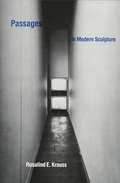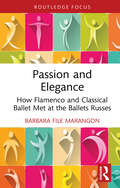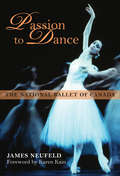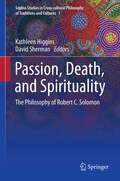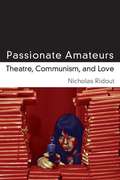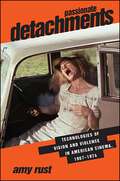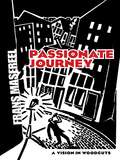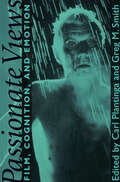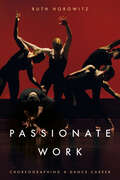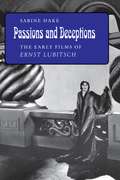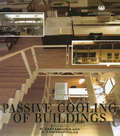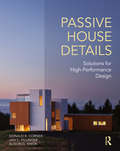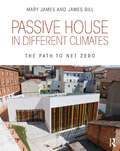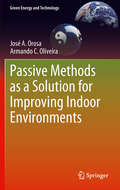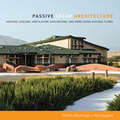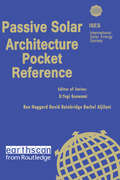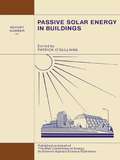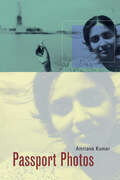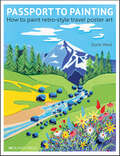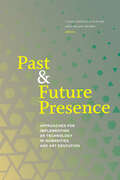- Table View
- List View
Passage to Afghanistan
by Peter BussianIn 2001, the Taliban approved Peter Bussian's request to photograph Afghanistan, asking him to "show the world the true Afghanistan," and for the past fifteen years, he's followed through on his promise to do so. In total, Bussian has spent nearly four years on the ground in Afghanistan, traveling there as both a photojournalist and with aid organizations such as the United Nations. In this entrancing volume, Bussian presents 150 photographs of what he calls "the land that time forgot." His captivating images feature everything from jaw-dropping landscapes-jagged mountains, desolate deserts, broad planes, and lush valleys-to its passionate people-Kabul street vendors and donkey cart drivers, devout Muslims, and displaced refugees.A fascinating introduction gives perspective on the special allure of the land-a place whose mystery was described by great poets, such as Rumi and Kipling, and that today is grounded in the fierce independence of its people, a physical and mental toughness that survives, even thrives, despite forty years of uninterrupted wars, and great famines.Side-by-side with the photographs are enlightening captions to give context to the compelling, memorable images. As a compilation, this is one of the most significant visual volumes of our time. While the world is at war with terrorism, Afghanistan, for many, represents the start of it all: the home of the terrorists behind 9/11 and the physical center of where America began its war on terrorism. To understand what we are up against and what follows Western intervention, here, at last, is a visual gateway: a portal to a significant, but little-understand land.
Passage to Israel
by Karen Lehrman Bloch Chloé Simone ValdaryBursting with lush, vibrant photographs, Passage to Israel is a timeless tribute to one of the world's most soulful, resolute, and newsworthy countries. Divided into sections such as Soul, Spirit, Awe, Quiet, and Unity, the stunning images featured inside capture Israel's glorious landscapes, its city life, its culture, and its people. From an enchanting sunset over the Dead Sea to the lively city life of Tel Aviv, from colorful marketeers to families in prayer at the Western Wall, this incredible volume moves full-steam ahead past the typical postcard images of the country to showcase the character of its people and the sanctity of the land they're so resolute in preserving. Contributors to Passage to Israel include twenty-five iconic and groundbreaking photographers, acclaimed artists such as Markus Gebauer and Amit Geron, and more than 150 of their images are featured inside. As a precursor to the images is an enlightening introduction by the author, a renowned cultural critic and curator, that provides a fascinating frame for the photographs to come.Throughout, explanatory captions are featured side-by-side with the images.For a country roughly the size of New Jersey and only formally declared a state in 1948, not too long ago, Israel is easily the world's most controversial land, one that's withstood regular suicide bombing, violent attacks, and political pressure. Yet its people refuse to be silenced; they will protect their borders and they will continue to persevere.For those who've been to Israel and those who've yet to make the trip there, here, at last, is a truly immersive experience, an inspiring visual connection to a remarkable, but faraway land
Passage to Wonderland
by Michael A. AmundsonIn 1903 the Cody Road opened, leading travelers from Cody, Wyoming, to Yellowstone National Park. Cheyenne photographer J. E. Stimson traveled the route during its first week in existence, documenting the road for the state of Wyoming's contribution to the 1904 World's Fair. His images of now-famous landmarks like Cedar Mountain, the Shoshone River, the Holy City, Chimney Rock, Sylvan Pass, and Sylvan Lake are some of the earliest existing photgraphs of the route. In 2008, 105 years later, Michael Amundson traveled the same road, carefully duplicating Stimson's iconic original photographs. In Passage to Wonderland, these images are paired side by side and accompanied by a detailed explanation of the land and history depicted. Amundson examines the physical changes along "the most scenic fifty miles in America" and explores the cultural and natural history behind them. This careful analysis of the paired images make Passage to Wonderland more than a "then and now" photography book--it is a unique exploration of the interconnectedness between the Old West and the New West. It will be a wonderful companion for those touring the Cody Road as well as those armchair tourists who can follow the road on Google Earth using the provided GPS coordinates.
Passage to Wonderland: Rephotographing Joseph Stimson's Views of the Cody Road to Yellowstone National Park, 1903 and 2008
by Michael A. AmundsonIn 1903 the Cody Road opened, leading travelers from Cody, Wyoming, to Yellowstone National Park. Cheyenne photographer J. E. Stimson traveled the route during its first week in existence, documenting the road for the state of Wyoming's contribution to the 1904 World's Fair. His images of now-famous landmarks like Cedar Mountain, the Shoshone River, the Holy City, Chimney Rock, Sylvan Pass, and Sylvan Lake are some of the earliest existing photographs of the route. In 2008, 105 years later, Michael Amundson traveled the same road, carefully duplicating Stimson's iconic original photographs. In Passage to Wonderland, these images are paired side by side and accompanied by a detailed explanation of the land and history depicted. Amundson examines the physical changes along "the most scenic fifty miles in America" and explores the cultural and natural history behind them. This careful analysis of the paired images make Passage to Wonderland more than a "then and now" photography book--it is a unique exploration of the interconnectedness between the Old West and the New West. It will be a wonderful companion for those touring the Cody Road as well as those armchair tourists who can follow the road on Google Earth using the provided GPS coordinates. The University Press of Colorado gratefully acknowledges the generous support of the Charles Redd Center for Western Studies at Brigham Young University toward the publication of this book.
Passages In Modern Sculpture
by Rosalind E. KraussStudies major works by important sculptors since Rodin in the light of different approaches to general sculptural issues to reveal the logical progressions from nineteenth-century figurative works to the conceptual work of the present.
Passion and Elegance: How Flamenco and Classical Ballet Met at the Ballets Russes (ISSN)
by Barbara File MarangonThis book commences with the history of Indian, Egyptian, Arab, and flamenco dance, then compares and contrasts the history of both classical ballet and flamenco.The book outlines the early roots of flamenco in India, and the journey of the Romani through the Middle East and Europe up to their final destination in Spain. Alongside this, the history of classical ballet is detailed from its beginning in Italy to its later development in France. The book spans the period from the temples of India to Massine’s Spanish ballet, The Three-cornered Hat, for the Ballets Russes. The chronicle of flamenco's journey from India to Spain is important to understanding the development of classical ballet as it relates to The Three-cornered Hat, which is the culmination of the story. The evolution of costumes, space, scenery, and props is examined along with the historical parallels.This exploration is set to inspire and encourage choreographers to partner other dance forms with ballet as Leonide Massine did with flamenco in The Three-cornered Hat while also challenging the anthropological idea of the language of dance movement tracing the migration of people.
Passion to Dance: The National Ballet of Canada
by James NeufeldThis is the story of the National Ballet of Canada – the people, the determination, and how at sixty it is still creating new work while still representing the classics. Passion to Dance is the story of the National Ballet of Canada – the people who dreamt the company into existence, the determination needed to keep it afloat, the bumps on the road to its success, and above all, its passion for dance as a living, evolving art form. From catch-as-catch-can beginnings – borrowed quarters, tiny stages, enormous dreams the National Ballet has emerged as one of North America’s foremost dance troupes. The company at sixty is a company of its time, engaged in creating challenging new work, yet committed to maintaining the classics of the past, favourites like Swan Lake, The Nutcracker,and The Sleeping Beauty. One hundred and fifty photographs from the company’s archives illustrate this definitive history, filled with eyewitness accounts, backstage glimpses, and fascinating detail. This is a record of one of Canada’s boldest cultural experiments, a book to enjoy now and keep forever.
Passion, Death, and Spirituality
by David Sherman Kathleen HigginsRobert C. Solomon, who died in 2007, was Professor of Philosophy and Quincy Lee Centennial Professor of Business at the University of Texas, USA. As the first book comprehensively to examine the breadth of Solomon's contribution to philosophy, this volume ranks as a vital addition to the literature. It includes a newly published transcript of Solomon's last talk, which responded to Arindam Chakrabarti on the concept of revenge, as well as the considered views of prominent figures in the numerous subfields in which Solomon worked. The content analyses his perspectives on the philosophy of emotion, virtue, business ethics, and religion, in addition to philosophical history, existentialism, and the many other topics that held this prolific thinker's attention. Solomon memorably defined philosophy itself as 'the thoughtful love of life', and despite the diversity of his output, he was most drawn by central questions about the meaning of life, the essential role that emotions play in finding that meaning, and the human imperative to seek 'emotional integrity', in which one's thoughts, emotions, and actions all contribute to a coherent narrative. The essays included here draw attention to the interconnections between the issues Solomon addressed, and evince the manner in which he embodied that integrity, living a life at one with his philosophy. They emphasize the central themes of passion, ethics, and spirituality, which threaded through his work, and the way these ideas informed his views on how we should approach grief and death. The multiplicity of topics alone make this keystone work an enlightening read for a full spectrum of students of philosophy, providing much to ponder and recounting a subtle and shining example of the emotional integrity Solomon worked so hard to define.
Passionate Amateurs: Theatre, Communism, And Love
by Nicholas RidoutPassionate Amateurs tells a new story about modern theater: the story of a romantic attachment to theater’s potential to produce surprising experiences of human community. It begins with one of the first great plays of modern European theater—Chekhov’s Uncle Vanya in Moscow—and then crosses the 20th and 21st centuries to look at how its story plays out in Weimar Republic Berlin, in the Paris of the 1960s, and in a spectrum of contemporary performance in Europe and the United States. This is a work of historical materialist theater scholarship, which combines a materialism grounded in a socialist tradition of cultural studies with some of the insights developed in recent years by theorists of affect, and addresses some fundamental questions about the social function and political potential of theater within modern capitalism. Passionate Amateurs argues that theater in modern capitalism can help us think afresh about notions of work, time, and freedom. Its title concept is a theoretical and historical figure, someone whose work in theater is undertaken within capitalism, but motivated by a love that desires something different. In addition to its theoretical originality, it offers a significant new reading of a major Chekhov play, the most sustained scholarly engagement to date with Benjamin’s “Program for a Proletarian Children’s Theatre,” the first major consideration of Godard’s La chinoise as a “theatrical” work, and the first chapter-length discussion of the work of The Nature Theatre of Oklahoma, an American company rapidly gaining a profile in the European theater scene. Passionate Amateurs contributes to the development of theater and performance studies in a way that moves beyond debates over the differences between theater and performance in order to tell a powerful, historically grounded story about what theater and performance are for in the modern world.
Passionate Detachments: Technologies of Vision and Violence in American Cinema, 1967-1974 (SUNY series, Horizons of Cinema)
by Amy RustPassionate Detachments investigates the rise of graphic violence in American films of the late 1960s and early 1970s and the popular aesthetics and critical responses this violence inspired. Amy Rust examines four technologies adopted by commercial American cinema after the fall of the Hollywood Production Code: multiple-camera montage, squibs (small explosive devices) and artificial blood, freeze-frames, and zooms. Approaching these technologies as figures, as opposed to mere tools, Rust traces the encounters they mediate between perception (what one sees, hears, and feels) and representation (how those sights, sounds, and feelings make meaning). These technologies, she argues, lend shape to film violence while organizing viewers' on- and off-screen relationships to it.The result proves meaningful for an era self-consciously and perilously preoccupied with bloodshed. The post-Code period found Americans across the political spectrum demanding visual—and increasingly violent—demonstrations of presumably "authentic" realities. Corroborating fantasies of authenticity from military to counterculture, these technologies challenge them as well, pointing, however unwittingly, to the violently classed, gendered, and racialized blind spots such fantasies harbor. More broadly, the technologies answer concerns that films control violence too much or too little. Offering neither mere discourse nor mere thrills, they recover sense and sensation for all, not some, or even most, depictions of bloodshed. As figures, the devices also remediate vision and violence for film theory, which exhibits distrust for each in spite of the complexities phenomenology and psychoanalysis have brought to cinematic perception and pleasure.
Passionate Journey: A Vision in Woodcuts (Dover Fine Art, History Of Art Series)
by Frans MasereelBelgian-born Frans Masereel (1889–1972) was one of the greatest woodcut artists of the twentieth century. Ingeniously portraying the human experience through dramatic art, this novel-without-words — crafted from 167 intricate woodcuts — is considered to be the Flemish artist's masterpiece.A feast for the eyes and the imagination, this powerful visual narrative details the life of an ordinary man. From the first bustling frame to the last haunting image, we are deeply drawn into the hero's day-to-day encounters, and discover a spirit in quest — one that we can profoundly relate to, emotionally and intellectually. Through each extraordinarily vivid depiction, readers feel the hero's happiness, grief, awe, and despair.
Passionate Playgoing in Early Modern England
by Allison P. HobgoodAllison P. Hobgood tells a new story about the emotional experiences of theatregoers in Renaissance England. Through detailed case studies of canonical plays by Shakespeare, Jonson, Kyd and Heywood, the reader will discover what it felt like to be part of performances in English theatre and appreciate the key role theatregoers played in the life of early modern drama. How were spectators moved - by delight, fear or shame, for example - and how did their own reactions in turn make an impact on stage performances? Addressing these questions and many more, this book discerns not just how theatregoers were altered by drama's affective encounters, but how they were undeniable influences upon those encounters. Overall, Hobgood reveals a unique collaboration between the English world and stage, one that significantly reshapes the ways we watch, read and understand early modern drama.
Passionate Views: Film, Cognition, and Emotion
by Carl Plantinga and Greg M. SmithThe movie theater has always been a place where people come together to share powerful emotional experiences, from the fear generated by horror films and the anxiety induced by thrillers to the laughter elicited by screwball comedies and the tears precipitated by melodramas. Indeed, the dependability of movies to provide such experiences lies at the center of the medium's appeal and power. Yet cinema's ability to influence, even manipulate, the emotions of the spectator is one of the least-explored topics in film theory today.In Passionate Views, thirteen internationally recognized scholars of film studies, philosophy, and psychology explore the emotional appeal of the cinema. Employing a novel cognitive perspective, the volume investigates the relationship between genre and emotion; explores how film narrative, music, and cinematic techniques such as the close-up are used to elicit emotion; and examines the spectator's identification with and response to film characters.An impressive range of films and topics is brought together by Carl Plantinga and Greg M. Smith, including: the success of Stella Dallas and An Affair to Remember as tearjerkers; the power of Night of the Living Dead to inspire fear and disgust; the sublime evoked in The Passion of Joan of Arc, Aguirre, the Wrath of God, and The Children of Paradise; the emotional basis of film comedy as seen in When Harry Met Sally; the use of cinematic cues in Raiders of the Lost Ark and Local Hero to arouse emotions; the relationship between narrative flow and emotion in Once Upon a Time in the West and E.T.; the emotive use of music in The Elephant Man and A Clockwork Orange; Stranger than Paradise's sense of timing; desire and resolution in Casablanca; audience identification with the main characters in Groundhog Day and The Crying Game; portrayal of perversity in The Silence of the Lambs, Flaming Creatures, and Shivers; and empathy elicited through closeups of actors' faces in Yankee Doodle Dandy and Blade Runner.Passionate Views offers a new approach to our understanding of film and will be of interest to anyone fascinated by the emotional power of motion pictures and their relationship to the central concerns of our lives, as well as by the techniques filmmakers use to move an audience.
Passionate Work: Choreographing a Dance Career
by Ruth HorowitzCorps de ballet literally means the "body" of the ballet company, and it refers to the group of dancers who are not principals. Another large group of dancers puts together portfolios of work, often across several dance companies. These categories of dancers typically don't have name recognition and yet comprise the majority of professional dancers today. The ways that they stitch together careers, through dedication, grit, and no small amount of skill – and the reasons they have for doing so without the promise of fame or fortune – are telling of broader trends that shape the precarious labor of professional dance, and creative careers more generally. In Passionate Work, dance hobbyist and sociologist, Ruth Horowitz captures their stories. When creative labor is studied, it is often thought of in opposition to more conventional work, and the primary metric that distinguishes them is passion. Professional creatives are not working in the traditional sense because they are following their passion. By tracing the careers of such dancers, Horowitz troubles the binary understanding of passion and work. A career in dance requires both, and approaching her subjects through this lens allows her to explore their strategies for sustaining passion through the ups and downs of a career. Horowitz explores how dancers evaluate the rewards and challenges of a notoriously underpaid, and uncertain profession. Horowitz considers major dimensions of a career in a performing art, documenting each stage in a dancer's life. Above all, she shines a light on the strategies used to achieve a sense of biographical continuity in a world often marked by discontinuity and rupture.
Passions and Deceptions: The Early Films of Ernst Lubitsch
by Sabine HakeA collaborator with Warner Brothers and Paramount in the early days of sound film, the German film director Ernst Lubitsch (1892-1947) is famous for his sense of ironic detachment and for the eroticism he infused into such comedies as So This Is Paris and Trouble in Paradise. In a general introduction to his silent and early sound films (1914-1932) and in close readings of his comedies, Sabine Hake focuses on the visual strategies Lubitsch used to convey irony and analyzes his contribution to the rise of classical narrative cinema. Exploring Lubitsch's depiction of femininity and the influence of his early German films on his entire career, she argues that his comedies represent an important outlet for dealing with sexual and cultural differences. The readings cover The Oyster Princess, The Doll, The Mountain Cat, Passion, Deception, So This Is Paris, Monte Carlo, and Trouble in Paradise, which are interpreted as part of an underlying process of negotiation between different modes of representation, narration, and spectatorship--a process that comprises the conditions of production in two different national cinemas and the ongoing changes in film technology. Drawing attention to Lubitsch's previously neglected German films, this book presents the years until 1922 as the formative period in his career.
Passive Cooling of Buildings: Passive Cooling Of Buildings (BEST (Buildings Energy and Solar Technology))
by D. AsimakopoulosEnergy use in buildings in the EU represents about 40% of the total annual energy consumption. With greater awareness of the need to reduce energy consumption comes a growth of interest in passive cooling, particularly as an alternative to air-conditioning. This book describes the fundamentals of passive cooling together with the principles and formulae necessary for its successful implementation. The material is comprised largely of information and results compiled under the SAVE European Research Programme.
Passive House Details: Solutions for High-Performance Design
by Alison G. Kwok Donald B. Corner Jan C. FillingerPassive House Details introduces the concepts, principles, and design processes of building ultralow-energy buildings. The objective of this book is to provide design goals, research, analysis, systems, details, and inspiring images of some of the most energy-efficient, carbon-neutral, healthy, and satisfying buildings currently built in the region. Other topics included: heat transfer, moisture management, performance targets, and climatic zones. Illustrated with more than 375 color images, the book is a visual catalog of construction details, materials, and systems drawn from projects contributed from forty firms. Fourteen in-depth case studies demonstrate the most energy-efficient systems for foundations, walls, floors, roofs, windows, doors, and more.
Passive House in Different Climates: The Path to Net Zero
by Mary James James BillPassive House in Different Climates introduces the seven Passive House principles, to help you create super-insulated, airtight buildings that require minimal energy use to heat, cool, dehumidify, and ventilate, with superior indoor air quality and year-round comfort. Seventeen case studies in four climate zones---marine, cold and very cold, mixed-dry and hot-dry, and mixed-humid and hot-humid---and in ten countries, show you how to achieve net-zero energy regardless of where you’re building or what type of building is required. Includes more than 150 color illustrations.
Passive Methods as a Solution for Improving Indoor Environments
by José A. Orosa Armando C. OliveiraThere are many aspects to consider when evaluating or improving an indoor environment; thermal comfort, energy saving, preservation of materials, hygiene and health are all key aspects which can be improved by passive methods of environmental control. Passive Methods as a Solution for Improving Indoor Environments endeavours to fill the lack of analysis in this area by using over ten years of research to illustrate the effects of methods such as thermal inertia and permeable coverings; for example, the use of permeable coverings is a well known passive method, but its effects and ways to improve indoor environments have been rarely analyzed. Passive Methods as a Solution for Improving Indoor Environments includes both software simulations and laboratory and field studies. Through these, the main parameters that characterize the behavior of internal coverings are defined. Furthermore, a new procedure is explained in depth which can be used to identify the real expected effects of permeable coverings such as energy conservation and local thermal comfort as well as their working periods in controlling indoor environments. This theoretical base is built on by considering future research work including patents and construction indications which will improve indoor environmental conditions with evidence from real data. This makes Passive Methods as a Solution for Improving Indoor Environments an ideal resource for specialists and researchers focusing on indoor air quality, thermal comfort, and energy saving or with a general interest in controlling indoor environments with passive methods.
Passive Solar Architecture
by David A. Bainbridge Ken HaggardThis pocket reference book provides a wealth of practical information at your fingertips, whenever you need it. Rich in background detail, at-a-glance tables and diagrams, equations, and more, the Passive Solar Architecture Pocket Referenceis a handy resource for architects, engineers and students. Coverage includes: Definitions Load determinants and Responses (including world wide biomes and climates, building metabolism and response, thermal sources and sinks, passive building responses to sources and sinks, tuning the building to the environment, optimizing insulation & thermal mass for comfort) Contextual Aspects (including microclimate and siting, temperatures, humidity, wind, radiation and comfort parameters) Passive Components (including building envelope, passive solar terminology, orientation, apertures and glazing, thermal storage, thermal control and materials Design Tools (including sun path diagrams, sun peg diagrams, air flow relationships, thermal modelling and life cycle design) Specific Functions (including passive heating, passive cooling and ventilation, natural lighting, passive water heating, resource collection and Integrated design)
Passive Solar Architecture Pocket Reference (Energy Pocket Reference)
by David A. Bainbridge Ken Haggard Rachel AljilaniOur pocket reference books provide a wealth of practical information at your fingertips, whenever you need it. Rich in background detail, at-a-glance tables and diagrams, equations, and more, the Passive Solar Architecture Pocket Reference is a handy resource for architects, engineers and students. Coverage includes: definitions load determinants and Responses (including world wide biomes and climates, building metabolism and response, thermal sources and sinks, passive building responses to sources and sinks, tuning the building to the environment, optimizing insulation & thermal mass for comfort) contextual aspects (including microclimate and siting, temperatures, humidity, wind, radiation and comfort parameters passive components (including building envelope, passive solar terminology, orientation, apertures and glazing, thermal storage, thermal control and materials design tools (including sun path diagrams, sun peg diagrams, air flow relationships, thermal modelling and life cycle design specific functions (including passive heating, passive cooling and ventilation, natural lighting, passive water heating, resource collection and integrated design).
Passive Solar Energy in Buildings: Watt Committee: report number 17
by Patrick O´SullivanThis report indicates that the benefits that accrue to a building and its occupants from a consideration of solar radiation are greatest when the 'passive solar component' is seen in perspective, as a natural part of an integrated approach to climatically interactive low-energy building design.
Passport Photos
by Amitava KumarPassport Photos, a self-conscious act of artistic and intellectual forgery, is a report on the immigrant condition. A multigenre book combining theory, poetry, cultural criticism, and photography, it explores the complexities of the immigration experience, intervening in the impersonal language of the state. Passport Photos joins books by writers like Edward Said and Trinh T. Minh-ha in the search for a new poetics and politics of diaspora. Organized as a passport, Passport Photos is a unique work, taking as its object of analysis and engagement the lived experience of post-coloniality--especially in the United States and India. The book is a collage, moving back and forth between places, historical moments, voices, and levels of analysis. Seeking to link cultural, political, and aesthetic critiques, it weaves together issues as diverse as Indian fiction written in English, signs put up by the border patrol at the U.S.-Tijuana border, ethnic restaurants in New York City, the history of Indian indenture in Trinidad, Native Americans at the Superbowl, and much more. The borders this book crosses again and again are those where critical theory meets popular journalism, and where political poetry encounters the work of documentary photography. The argument for such border crossings lies in the reality of people's lives. This thought-provoking book explores that reality, as it brings postcolonial theory to a personal level and investigates global influences on local lives of immigrants.
Passport to Painting: How to Paint Retro-Style Travel Poster Art
by Susie WestStylish retro travel posters bring to mind summer holidays, happiness and fun. Perennially popular as wall art, their strong designs and clean, flat colours are perfect for hobby artists to emulate.A complete guide to producing your own travel-poster art, this book includes guidance on composing a strong design, selecting colours to make sure your artwork pops, and adding lettering for a picture-perfect finished poster.Learn to create key poster elements such as clouds, skies, water and architecture, and discover how to add your own stylized lettering. There are six striking international projects to complete, or you can use your newfound skills to celebrate your own home town or treasured place. This book is packed with examples of Susie West’s inspiring artwork and a short history of travel posters.Since 2015, Susie West has been working her way around the UK recreating the upbeat, retro charm of travel posters in the modern world. This book shares her techniques and secrets for producing fun, charming artwork. Suitable for beginners, this is a great way into art for those who want to develop their skills, or for experienced artists wanting to try something new.
Past and Future Presence: Approaches for Implementing XR Technology in Humanities and Art Education
by Brian Beams Lissa Crofton-SleighWhile uses and studies of XR technology within STEM-based education have been plentiful in recent years, there has been lesser or even, at times, a lack of coverage for this novel learning tool in the arts and humanities.Past and Future Presence aims to bridge some of that gap by presenting research-based theory and case studies of successful application and implementation of XR technology into postsecondary educational settings, ranging in topics from ancient to modern languages, classical and contemporary art, and reenvisioned historical scenes and events presented in ways never seen before. The studies also contemplate how this novel medium can enhance and supplement learning in classrooms and other formal or informal learning environments. The volume as a whole is intended to demonstrate to educators, scholars, and researchers in higher education the potential value of integrating XR technology into their classrooms and to provide a strong argument for college and university administrators to invest in training and development of new research and content for classrooms inside and outside of STEM. The authors of these chapters come from a diverse range of backgrounds at different stages of their careers, providing a broad crosssection of scholastic work within the humanities and arts. Each chapter offers a different angle or approach to incorporating XR technology into teaching or research within different subject areas. As the volume suggests, this technology also places additional emphasis on the humanity within the humanities, by focusing on increasing connection between users and different cultures, time periods, and perspectives.




